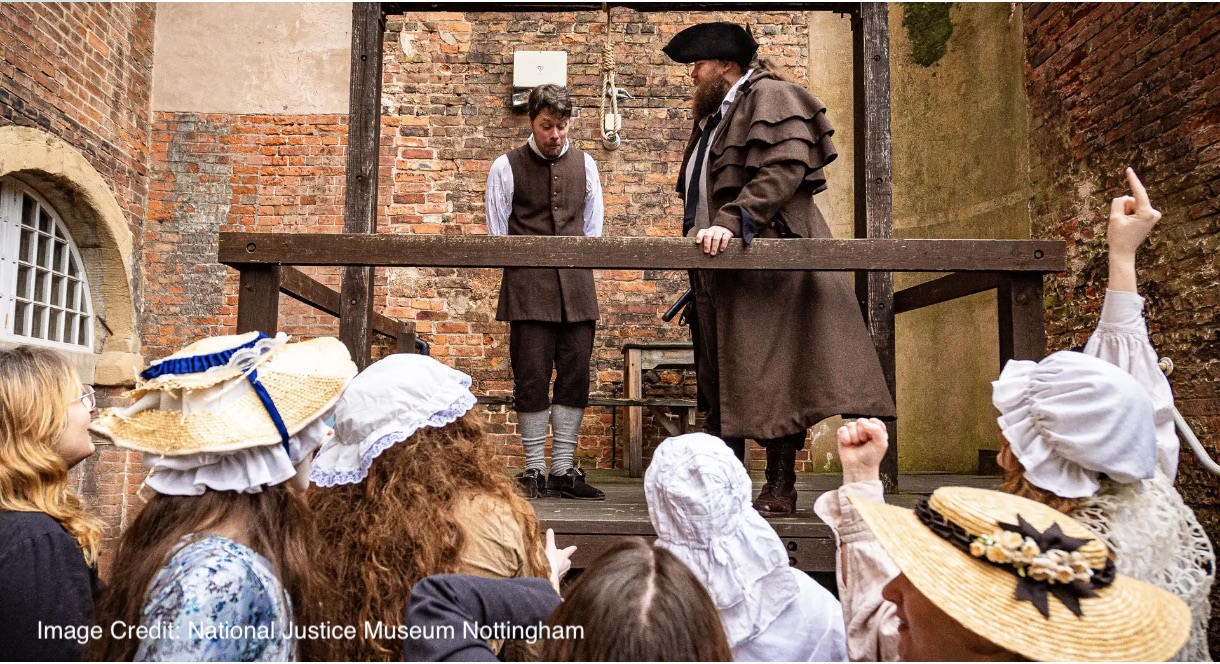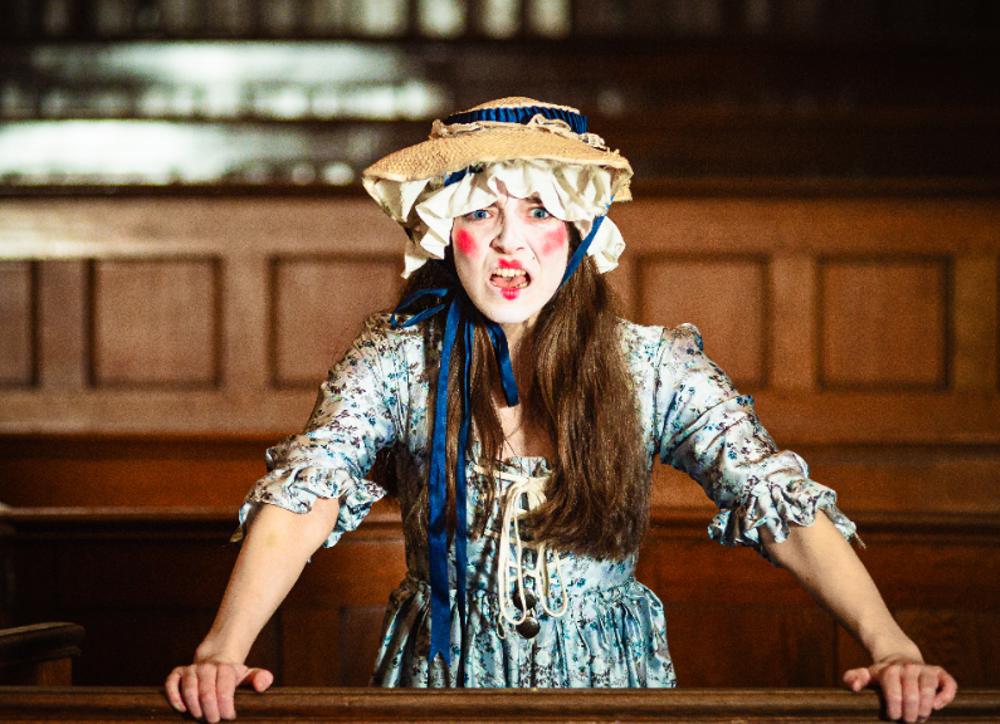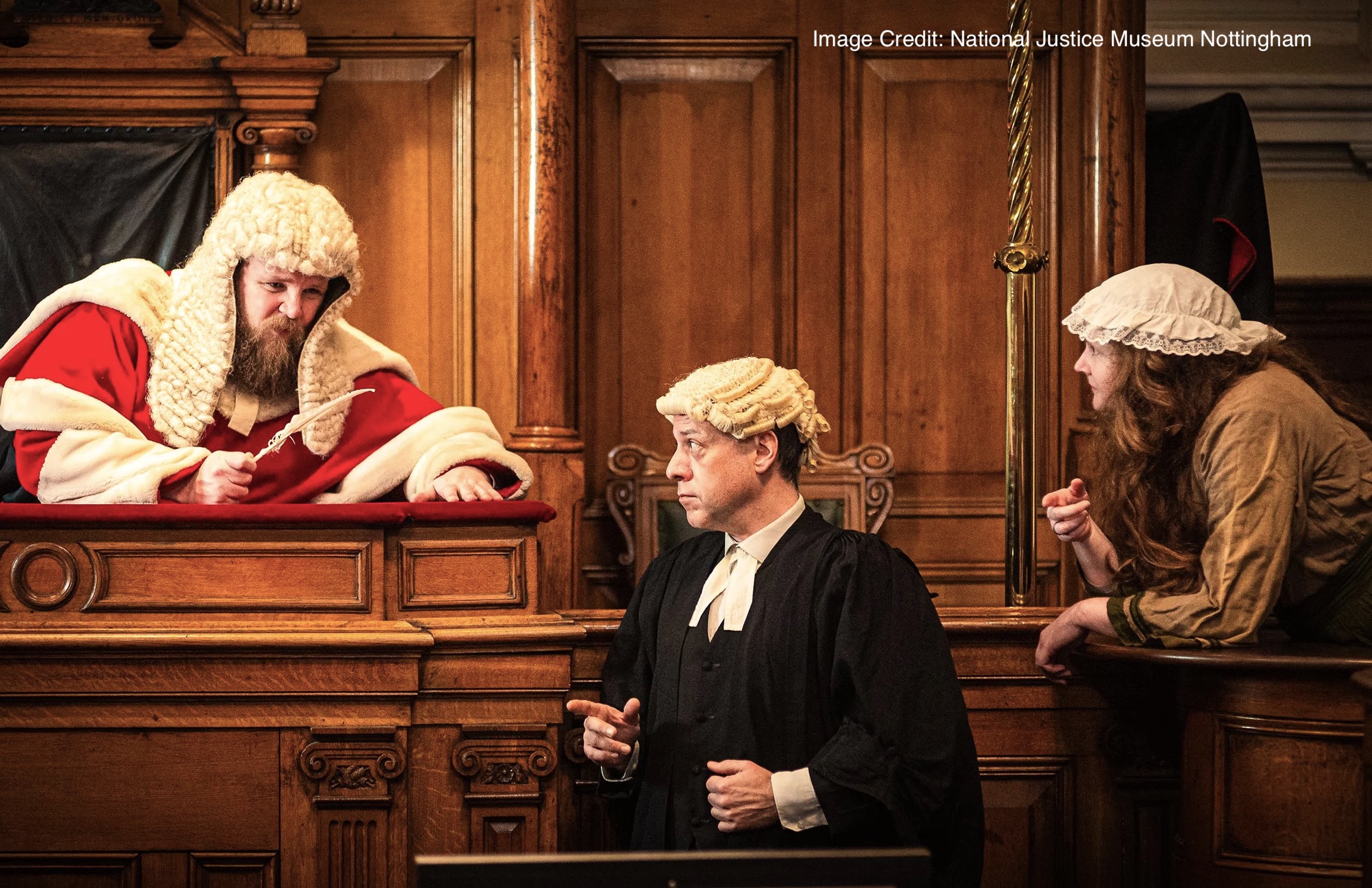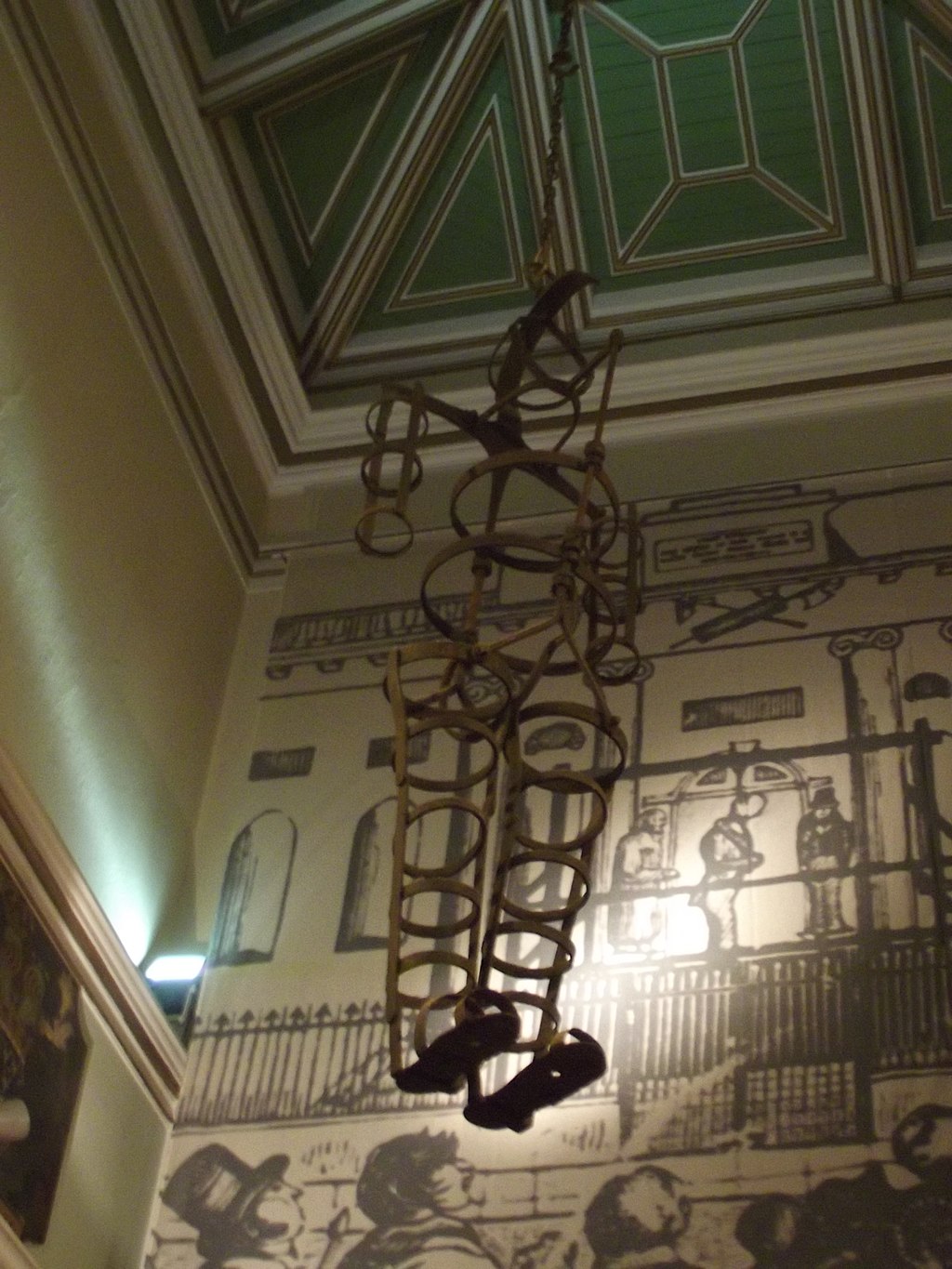Case Study
Nottingham’s National Justice Museum. Bringing History to Life Through Costumed Interpretation
Stephen Dennis, Head of Costumed Interpretation
Background
The National Justice Museum in Nottingham has developed a distinctive approach to visitor engagement. Rather than relying heavily on digital technology, the museum draws upon the power of costumed interpretation to animate its historic setting and complex subject matter.
This case study explores how the museum has used character-led storytelling to bring its themes of crime, punishment, and justice to life, while addressing the challenges of presenting such a sensitive and often dark history in an accessible and engaging way.The National Justice Museum in Nottingham has developed a distinctive approach to visitor engagement. Rather than relying heavily on digital technology, the museum draws upon the power of costumed interpretation to animate its historic setting and complex subject matter.
This case study explores how the museum has used character-led storytelling to bring its themes of crime, punishment, and justice to life, while addressing the challenges of presenting such a sensitive and often dark history in an accessible and engaging way.
Housed in a historic building that served as both court and jail for over 600 years, the National Justice Museum provides an authentic backdrop for exploring the history of law and crime in Britain. Since opening as a museum in 1995, it has deliberately chosen to focus on live, costumed interpretation as its primary interpretive tool. This decision reflects the belief that personal encounters with characters from the past can offer richer insights than static displays or screens.
The museum faces a unique challenge compared to many heritage attractions. Unlike historic houses, which often present domestic or decorative narratives, the National Justice Museum deals with crime, incarceration, and punishment—subjects that can feel intimidating or unsettling. Authority figures such as prison wardens, when portrayed in full uniform, can appear threatening. Visitors’ instinct may be to avoid interaction. The key difficulty has therefore been striking a balance: remaining historically accurate while also ensuring that the visitor experience is welcoming, approachable, and thought-provoking rather than overwhelming.
Approaches
The museum developed a suite of interpretive approaches designed to immerse visitors in the justice system while allowing them to engage at their own pace. These include:
- First-Person Interpretation – Guides in costume interact directly with visitors as historical figures.
- Re-enactments – Short staged performances of historic events, including executions, open for audiences who choose to attend.
- Courtroom Role-Play – Interactive mock trials in the museum’s historic courtroom, with visitors taking on roles such as barristers, witnesses, and jurors.
- Personalised Visitor Experiences – Wristbands with convict numbers assign each visitor a crime, enabling costumed staff to engage them in tailored conversations.
- Character Research and Storytelling – Staff base their portrayals on real historical individuals, adding authenticity and depth.
Resources
Rethinking Heritage Futures, Online Workshop “Improving the Visitor Experience”, 27 November 2024, Nottingham Trent University (NTU), Communication University of China (CUC).
Approches
1. First-Person Interpretation: Meeting History Face-to-Face
When visitors encounter costumed guides at the museum, they are not meeting generic interpreters but characters drawn from history—wardens, prisoners, or reformers. This approach helps visitors imagine who once inhabited the building and what their lives might have been like.
The challenge, however, lies in the setting itself. A prison is not a comfortable environment, and authority figures such as jailers in uniform can appear intimidating. Some visitors instinctively turn away rather than engage. Interpreters must therefore tread a fine line: staying true to their roles while also remaining approachable.
Success is when conversations are sparked. Visitors soon realise that behind the uniform is someone ready to share stories, answer questions, and even inject humour. For many, this direct human connection makes the heavy subject matter more accessible, turning what might have been a bleak encounter into a memorable learning experience. The Encounters with jailers, reformers, or prisoners humanise history and transform stereotypes.
2. Re-enactments: History on Stage
Several times a day, the museum offers short re-enactments, often of dramatic events such as public executions. These performances give visitors the opportunity to witness how justice was carried out centuries ago.
The subject matter is sensitive, and the museum recognises the risk of alienating audiences. Rather than forcing participation, re-enactments are presented as optional events, allowing visitors to choose whether to attend. The performers themselves face the challenge of presenting executions authentically without resorting to sensationalism or overwhelming audiences.
Despite these difficulties, the re-enactments are popular. They bring a sense of theatre to the site, transforming abstract ideas of “punishment” into vivid experiences. Importantly, they remind visitors that the stories being told are not fictional—they are grounded in real cases and real lives.
3. Courtroom Role-Play: Justice in Visitors’ Hands
One of the most engaging experiences offered by the museum takes place in its historic courtroom. Here, visitors step into the shoes of barristers, judges, witnesses, and jurors. Guided by costumed interpreters, they recreate real trials from the building’s past.
Involving everyday visitors—most of whom have no acting experience—in a way that feels fun rather than daunting is a difficult task. Interpreters use humour and light-hearted improvisation to put participants at ease, while still grounding the performance in historical fact.
This blend of entertainment and education has proven highly effective. Audiences not only pay close attention but also become emotionally invested in the verdicts they deliver. The museum refreshes the cases regularly, ensuring that repeat visitors can return to new stories. By the end of each session, the entire room has shared in an experience that is equal parts theatre, history, and civic reflection.
4. Personalised Visitor Experiences
To make the experience even more immersive, every visitor receives a wristband on entry with a unique convict number. Hidden around the museum are boards revealing the crime linked to each number. This system allows costumed staff to personalise interactions on the spot.
For example, a jailer might stop a visitor and demand to know their convict number. When the number is revealed, the interpreter can describe the crime committed and the punishment awaiting them, leading naturally into conversation.
However, some visitors are reluctant to role-play, especially when labelled as criminals. Interpreters must quickly read the situation and adapt, softening their performance if necessary. When handled with care, however, these encounters become highlights. They transform visitors from passive observers into participants in the justice system’s story.
5. Character Research and Storytelling: Humanising History
Interpreters base their characters on real historical figures, ensuring that the stories told are grounded in fact. Behind every costume is months of research. This depth of knowledge means that when visitors ask questions, they receive answers that are both accurate and human.
One particularly engaging example is the portrayal of a Georgian jailer who later gave up his post to become an art teacher. His son, Richard Parkes Bonington, went on to become a celebrated Nottingham artist. When interpreters embody this character, they sit painting while in uniform, prompting visitors to ask why a stern jailer is working on an artwork. The answer—that this was part of his real-life story—surprises audiences, breaking stereotypes and sparking curiosity. Through such storytelling, the museum achieves what panels and labels alone cannot: it connects visitors with the personal, human side of history.
Challenges and Successes
Challenges
Balancing Authenticity and Accessibility. Presenting crime and punishment realistically without intimidating or distressing visitors.
Ensuring authority figures (e.g., wardens) remain approachable despite historically accurate uniforms.Sensitive Subject Matter. Interpreting executions, incarceration, and justice in a way that is respectful and not sensationalised.
Managing emotional responses from visitors to disturbing historical themes.Visitor Engagement Levels. Encouraging participation from visitors who may feel shy, uncomfortable, or reluctant to role-play.
Maintaining interest across diverse age groups and learning styles.Performer Challenges: Interpreters must balance character authenticity with empathy and flexibility.
Avoiding performances that feel too scripted or too theatrical.Complex Interpretation Setting. Delivering meaningful experiences within a historically heavy environment—a former court and jail.
Preventing the atmosphere from feeling oppressive or overly sombre.
Successes
Human Connection through First-Person Interpretation. Costumed characters foster personal conversations that humanise history. Visitors connect emotionally and intellectually with real people from the past.
Engaging Re-enactments. Dramatic performances bring history vividly to life. Optional attendance respects visitor comfort while maintaining authenticity.
Interactive Courtroom Role-Play. Visitors become active participants, enhancing learning and enjoyment. Humour and improvisation make complex legal stories accessible and memorable.
Personalised Visitor Experiences. Visitors feel directly involved in the justice narrative rather than passive observers.
Authentic, Research-Based Storytelling. Characters are grounded in real historical research, adding credibility and depth. Storylines challenge stereotypes and reveal unexpected, human sides of history.
Balancing Education and Emotion. The museum successfully combines factual history with empathy and entertainment. Visitors leave with deeper understanding and reflection on justice, humanity, and moral complexity.
Discussion
The National Justice Museum demonstrates how costumed interpretation can transform a challenging subject matter into an interactive, human-centred experience. By combining historical accuracy with theatrical engagement, the museum helps visitors understand not only the systems of law and punishment but also the lived experiences of those who passed through its doors. This approach illustrates the power of storytelling in heritage interpretation, proving that even the darkest histories can be shared in ways that are both respectful and compelling.
Further Resources
Websites:
Images
Image Credit: National Justice Museum Nottingham, official website.




